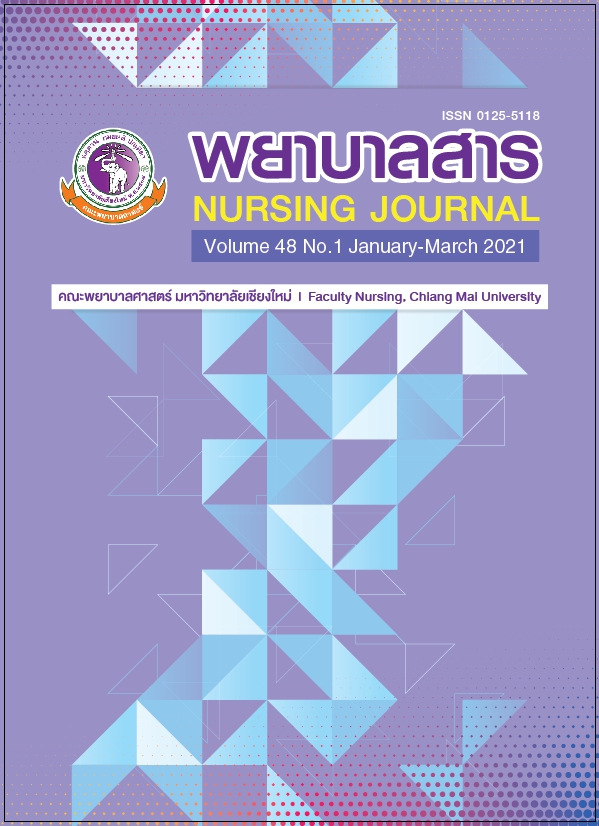Effect of a Contraceptive Promotion Program on Knowledge and Intention of Contraceptive Use Among Adolescent Mothers
Keywords:
The Contraceptive Promotion Program, Adolescent mothers, Knowledge, Intention, Repeated pregnancyAbstract
Repeated pregnancy in postpartum adolescents affects their physical and psychosocial wellbeing. These effects also extend to the newborn, the family, the economy and society. This quasi-experimental study aimed to examine the knowledge and intention of postpartum teenage mothers after received the Contraceptive Promotion Program. The participants were 160 adolescents receiving services from postpartum units in 4 hospitals in Northern Thailand from August 2018 to November 2019. The participants were purposively selected and divided into a control group (n=80) and an experimental group (n=80). The control group received routine postpartum care, while the experimental group participated in the Contraceptive Promotion Program. The research instruments consisted of 1) the Contraceptive Promotion Program, 2) the Handbook of Contraceptive Used for Adolescent Mothers, 3) the Knowledge of Contraception Assessment Form, and 4) the Intention of Contraceptive Use Recording Form. Data were analyzed using descriptive statistics and Mann Whitney-U test.
The results revealed that:
- After the intervention, the knowledge score of contraception in the experimental group was different from the control group (p <.001).
- After the intervention, the intention score of the experimental group was different from the control group (p =.01).
The results of this study showed that the Contraceptive Promotion Program can increase knowledge and intention of contraceptive use in adolescent mothers. Nurse-midwives can use these findings as a guideline to promote intention of contraceptive use and to prevent repeated pregnancy in adolescent mothers.
References
Bucknall, A. & Bick, D. (2019). Repeat pregnancies in teenage mothers: An exploratory study. Journal of Advance Nursing, 75, 2923-2933.
Bureau of Policy and Strategy, Ministry of Public Health. (2016). Number and rate of reproductive
age per 1,000 female population by maternal age group during 2002-2014. Retrieved from
http://social.nesdb.go.th/SocialStat/StatPieChart_Final.aspx?reportid=215&template
=1R2C&yeartype=M&subcatid=15. (In Thai)
Bureau of Reproductive Health, Ministry of Public Health. (2020). Handbook of Family Planning for Public Health Personal. Bangkok: Veterans Organization. (In Thai)
Ganchimeg, T., Ota, E., Morisaki, N., Laopaiboon, M., Lumbiganon, P., Zhang, J…. et al. (2014).
Pregnancy and childbirth outcomes among adolescent mothers: A World Health
Organization multicountry study. Bjog. 121(S Suppl 1):40-8.
Gray, J., Grove, S., & Sutherland, S. (2017). Burns and Grove's The Practice of Nursing Research. (8th ed). Missouri: Elsevier.
Health Asemmbly. (2017). Problems solving in Thai adolescents with unplanned pregnancy. Retrieved from https://www.samatcha.org/node/105. (In Thai)
Herrman, J. W. (2007). Repeat pregnancy in adolescent intention and decision making. Journal of Maternal Child Nursing, 32(2), 89-74.
Jantarasuk, C., Sriarporn, P., & Parisunyakul, S. (2016). Effects of promoting attitude and subjective norm on intention and contraceptive used among postpartum adolescents. Nursing Journal, 42(2) 104-115. (in Thai)
Kaewkiattikun, K. (2017). Effects of immediate postpartum contraceptive counseling on long-acting reversible contraceptive use in adolescents. Adolescent Health, Medicine and Therapeutics, 8, 115-123. (In Thai)
Kelsey, S. (2017). Contraception for teenagers: Acessable sexual health advice. Practice Nursing 28(6):236-241
Ladewig, A. W., London, M. L., & Davidson, M. R. (2014). Contemporary maternal newborn nursing care (8th ed.). St. Louis: Pearson Prentice Hall.
Lardizabal, S.A.et al. (1970). Methods and Principles of Teaching. Quezon City: Alemar-
Phoenix.
Moontito, V., Sriarporn, P., & Baosoung, C. (2017). Postpartum Depression, Social Support,
and Functional Status Among Adolescent Mothers. Nursing Journal, 44(2) 23-33.
(in Thai)
Norton, M., Chandra-Mouli, V., Lane, C. (2017). Interventions for preventing unintended, rapid
repeat pregnancy among adolescents: A review of the evidence and lessons from
high-quality evaluations. Glob Health Sci Pract, 5(4):547–70. doi: 10.9745/GHSP-D-17-
Pansuwan, K. (2016). Quality of Life in Postpartum Mothers, Neimueng District Amphure Mueng
Kamphaeng Phet Province. Journal of Health and Nursing Research. 9(2), 1-9. (In Thai)
Pungbangkadee, R., & Ratinthorn, A. (2015). Factors and consequences of repeat pregnancy
among teenagers: A case study in Bangkok metropolis. Journal of Nursing science,
(2), 23 – 31. (In Thai)
Senate of Health Committee. (2011). The Report of Consideration Studies on Adolescent Pregnancy. Bangkok: Office of the Commissioner 3, Office of the Secretary-General of the Senate. (In Thai)
Wisarutkasempong, A., & Muangpin, S. (2016). Factors Related to the Intention to Repeat
Pregnancy among Pregnant Adolescents. Srinagarind Medical Journal, 30(3), 1-9.
(In Thai)
World Health Organization (WHO). (2020). Adolescent pregnancy. Retrieved from https://www.who.int/news-room/fact-sheets/detail/adolescent-pregnancy
Downloads
Published
How to Cite
Issue
Section
License
บทความที่ได้รับการตีพิมพ์เป็นลิขสิทธิ์ของวารสารพยาบาลสาร
ข้อความที่ปรากฏในบทความแต่ละเรื่องในวารสารวิชาการเล่มนี้เป็นความคิดเห็นส่วนตัวของผู้เขียนแต่ละท่านไม่เกี่ยวข้องกับมหาวิทยาลัยเชียงใหม่ และคณาจารย์ท่านอื่นๆในมหาวิทยาลัยฯ แต่อย่างใด ความรับผิดชอบองค์ประกอบทั้งหมดของบทความแต่ละเรื่องเป็นของผู้เขียนแต่ละท่าน หากมีความผิดพลาดใด ๆ ผู้เขียนแต่ละท่านจะรับผิดชอบบทความของตนเองแต่ผู้เดียว






